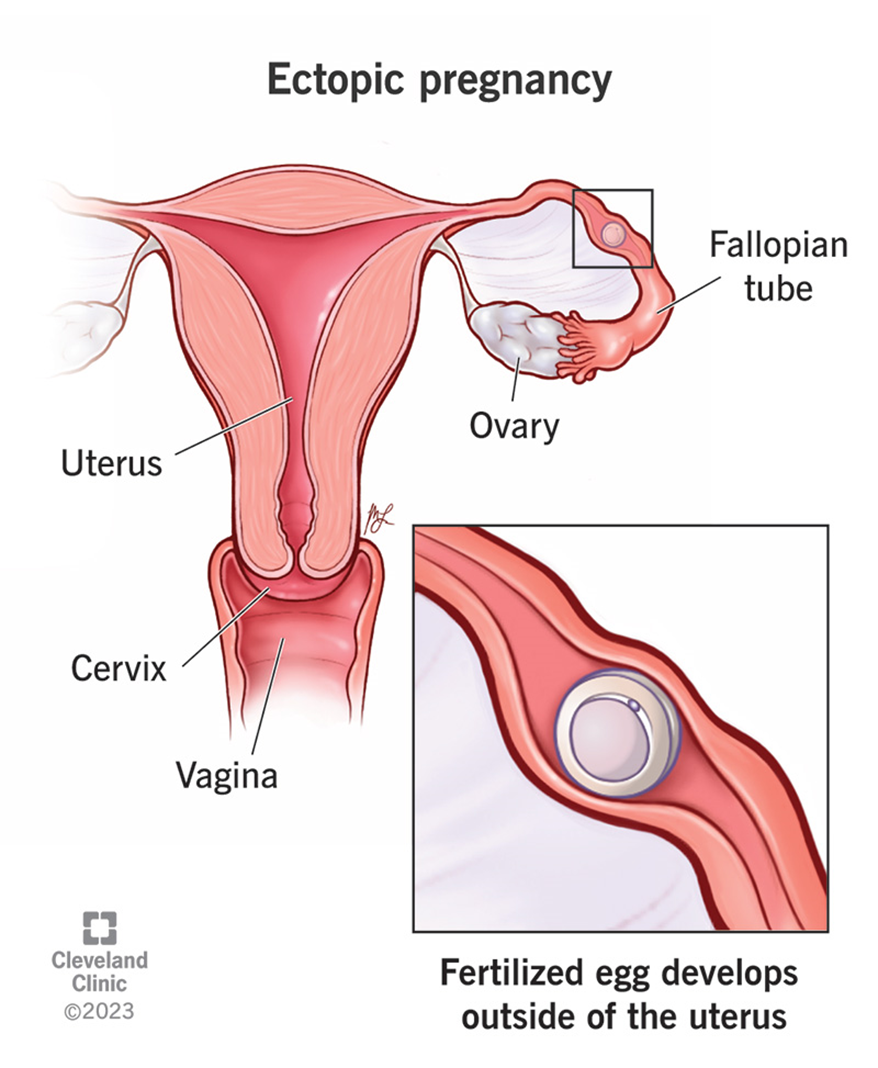A nurse is caring for a client who has a suspected ectopic pregnancy at 8 weeks of gestation. Which of the following manifestations should the nurse expect to identify as consistent with the diagnosis?
Large amount of vaginal bleeding
Uterine enlargement greater than expected for gestational age
Severe nausea and vomiting
Unilateral, cramp-like abdominal pain
The Correct Answer is D
Choice A reason:
A large amount of vaginal bleeding is not typically associated with an ectopic pregnancy. While some vaginal bleeding can occur, it is usually light and not the primary symptom. Heavy bleeding is more commonly associated with other complications such as miscarriage or placental issues.
Choice B reason:
Uterine enlargement greater than expected for gestational age is not a characteristic of ectopic pregnancy. In fact, the uterus may not enlarge significantly because the pregnancy is occurring outside the uterine cavity. This symptom is more indicative of conditions like molar pregnancy.
Choice C reason:
Severe nausea and vomiting are common symptoms of a normal pregnancy due to hormonal changes but are not specific to ectopic pregnancy. While some women with ectopic pregnancies may experience nausea and vomiting, these symptoms alone are not diagnostic.
Choice D reason:
Unilateral, cramp-like abdominal pain is a hallmark symptom of ectopic pregnancy. This pain typically occurs on one side of the abdomen, corresponding to the location of the ectopic implantation, usually in a fallopian tube. The pain can become severe and is often accompanied by light vaginal bleeding. If the fallopian tube ruptures, the pain can become intense and may be accompanied by signs of internal bleeding, such as dizziness, shoulder pain, and shock.

Nursing Test Bank
Naxlex Comprehensive Predictor Exams
Related Questions
Correct Answer is B
Explanation
Choice A Reason:
While assessing bowel sounds is important for overall patient care, it is not the priority when administering magnesium sulfate. Magnesium sulfate is primarily used to prevent seizures in preeclampsia and to manage preterm labor. Its side effects can include respiratory depression, making respiratory rate the most critical assessment.
Choice B Reason:
Respiratory rate is the priority assessment when administering magnesium sulfate. Magnesium sulfate can cause respiratory depression, which can be life-threatening. Monitoring the respiratory rate helps ensure that the client is not experiencing adverse effects from the medication. The normal respiratory rate for adults is 12-20 breaths per minute.
Choice C Reason:
Temperature monitoring is important for detecting infections and other conditions, but it is not the priority in this context. Magnesium sulfate does not typically affect body temperature, so this assessment is less critical compared to respiratory rate.
Choice D Reason:
Fetal heart rate (FHR) monitoring is crucial for assessing fetal well-being, especially in clients with preeclampsia or preterm labor. However, the immediate priority when administering magnesium sulfate is to monitor the mother’s respiratory rate to prevent respiratory depression.
Correct Answer is D
Explanation
Choice A Reason:
Covering the cord with a sterile, moist saline dressing is important to prevent the cord from drying out and to reduce the risk of infection. However, this is not the immediate priority. The primary concern is to relieve pressure on the cord to ensure adequate blood flow and oxygen to the fetus.
Choice B Reason:
Placing the client in the knee-chest position helps to relieve pressure on the umbilical cord by using gravity to shift the fetus away from the pelvis. This is a crucial step, but it should be done after manually relieving the pressure on the cord with a gloved hand.
Choice C Reason:
Preparing the client for an immediate birth is necessary if the cord prolapse cannot be resolved quickly. However, the first action should be to manually relieve the pressure on the cord to prevent fetal hypoxia while preparations for delivery are made
Choice D Reason:
Inserting a gloved hand into the vagina to relieve pressure on the cord is the immediate priority. This action directly addresses the risk of compromised blood flow and oxygen supply to the fetus, which is the most urgent concern in the case of a cord prolapse.

Whether you are a student looking to ace your exams or a practicing nurse seeking to enhance your expertise , our nursing education contents will empower you with the confidence and competence to make a difference in the lives of patients and become a respected leader in the healthcare field.
Visit Naxlex, invest in your future and unlock endless possibilities with our unparalleled nursing education contents today
Report Wrong Answer on the Current Question
Do you disagree with the answer? If yes, what is your expected answer? Explain.
Kindly be descriptive with the issue you are facing.
